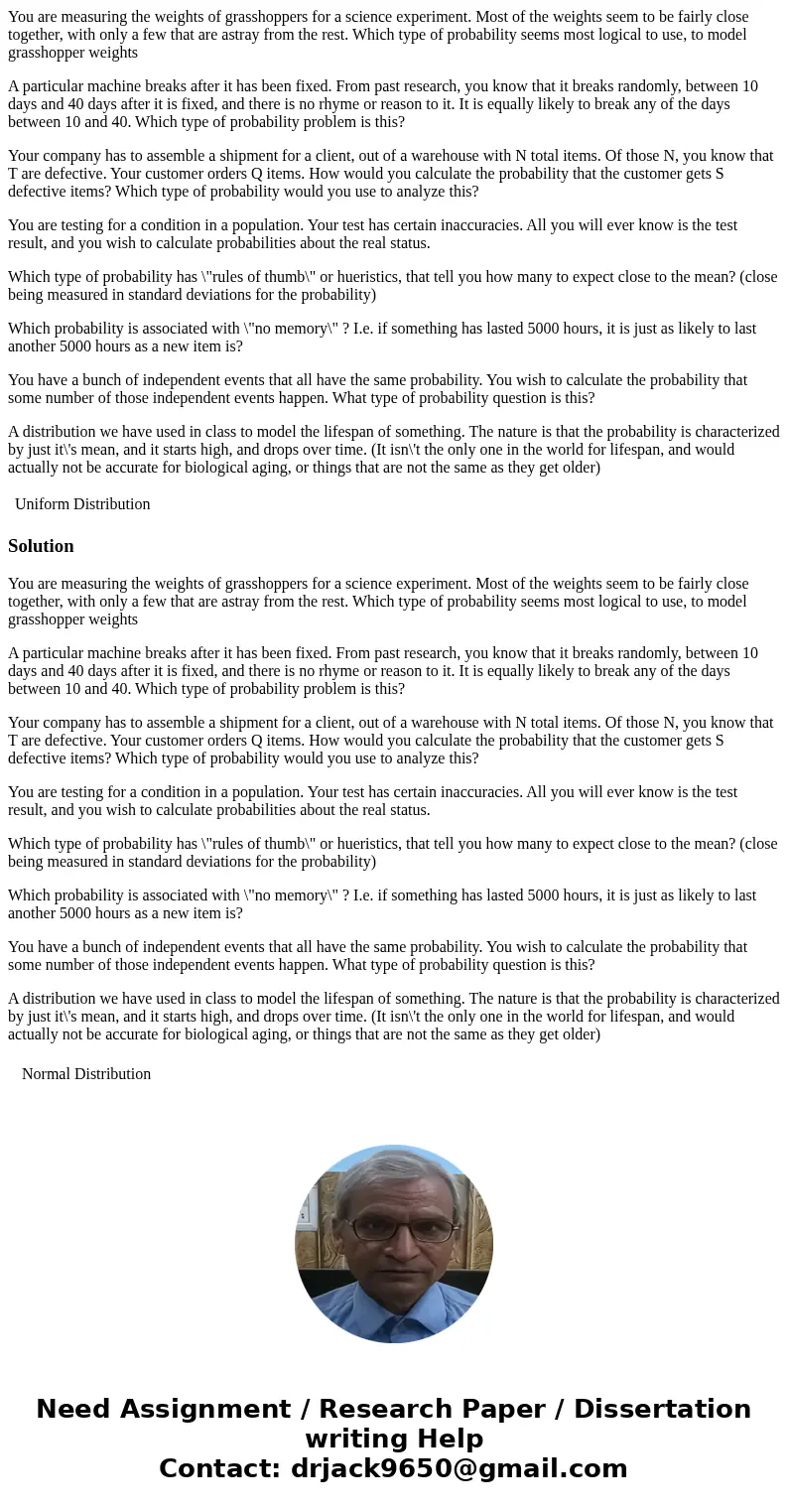You are measuring the weights of grasshoppers for a science
You are measuring the weights of grasshoppers for a science experiment. Most of the weights seem to be fairly close together, with only a few that are astray from the rest. Which type of probability seems most logical to use, to model grasshopper weights
A particular machine breaks after it has been fixed. From past research, you know that it breaks randomly, between 10 days and 40 days after it is fixed, and there is no rhyme or reason to it. It is equally likely to break any of the days between 10 and 40. Which type of probability problem is this?
Your company has to assemble a shipment for a client, out of a warehouse with N total items. Of those N, you know that T are defective. Your customer orders Q items. How would you calculate the probability that the customer gets S defective items? Which type of probability would you use to analyze this?
You are testing for a condition in a population. Your test has certain inaccuracies. All you will ever know is the test result, and you wish to calculate probabilities about the real status.
Which type of probability has \"rules of thumb\" or hueristics, that tell you how many to expect close to the mean? (close being measured in standard deviations for the probability)
Which probability is associated with \"no memory\" ? I.e. if something has lasted 5000 hours, it is just as likely to last another 5000 hours as a new item is?
You have a bunch of independent events that all have the same probability. You wish to calculate the probability that some number of those independent events happen. What type of probability question is this?
A distribution we have used in class to model the lifespan of something. The nature is that the probability is characterized by just it\'s mean, and it starts high, and drops over time. (It isn\'t the only one in the world for lifespan, and would actually not be accurate for biological aging, or things that are not the same as they get older)
| Uniform Distribution |
Solution
You are measuring the weights of grasshoppers for a science experiment. Most of the weights seem to be fairly close together, with only a few that are astray from the rest. Which type of probability seems most logical to use, to model grasshopper weights
A particular machine breaks after it has been fixed. From past research, you know that it breaks randomly, between 10 days and 40 days after it is fixed, and there is no rhyme or reason to it. It is equally likely to break any of the days between 10 and 40. Which type of probability problem is this?
Your company has to assemble a shipment for a client, out of a warehouse with N total items. Of those N, you know that T are defective. Your customer orders Q items. How would you calculate the probability that the customer gets S defective items? Which type of probability would you use to analyze this?
You are testing for a condition in a population. Your test has certain inaccuracies. All you will ever know is the test result, and you wish to calculate probabilities about the real status.
Which type of probability has \"rules of thumb\" or hueristics, that tell you how many to expect close to the mean? (close being measured in standard deviations for the probability)
Which probability is associated with \"no memory\" ? I.e. if something has lasted 5000 hours, it is just as likely to last another 5000 hours as a new item is?
You have a bunch of independent events that all have the same probability. You wish to calculate the probability that some number of those independent events happen. What type of probability question is this?
A distribution we have used in class to model the lifespan of something. The nature is that the probability is characterized by just it\'s mean, and it starts high, and drops over time. (It isn\'t the only one in the world for lifespan, and would actually not be accurate for biological aging, or things that are not the same as they get older)
|

 Homework Sourse
Homework Sourse